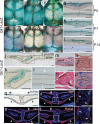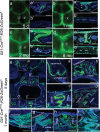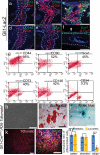The suture provides a niche for mesenchymal stem cells of craniofacial bones
- PMID: 25799059
- PMCID: PMC4380556
- DOI: 10.1038/ncb3139
The suture provides a niche for mesenchymal stem cells of craniofacial bones
Abstract
Bone tissue undergoes constant turnover supported by stem cells. Recent studies showed that perivascular mesenchymal stem cells (MSCs) contribute to the turnover of long bones. Craniofacial bones are flat bones derived from a different embryonic origin than the long bones. The identity and regulating niche for craniofacial-bone MSCs remain unknown. Here, we identify Gli1+ cells within the suture mesenchyme as the main MSC population for craniofacial bones. They are not associated with vasculature, give rise to all craniofacial bones in the adult and are activated during injury repair. Gli1+ cells are typical MSCs in vitro. Ablation of Gli1+ cells leads to craniosynostosis and arrest of skull growth, indicating that these cells are an indispensable stem cell population. Twist1(+/-) mice with craniosynostosis show reduced Gli1+ MSCs in sutures, suggesting that craniosynostosis may result from diminished suture stem cells. Our study indicates that craniofacial sutures provide a unique niche for MSCs for craniofacial bone homeostasis and repair.
Figures







References
Publication types
MeSH terms
Substances
Grants and funding
LinkOut - more resources
Full Text Sources
Other Literature Sources
Molecular Biology Databases

